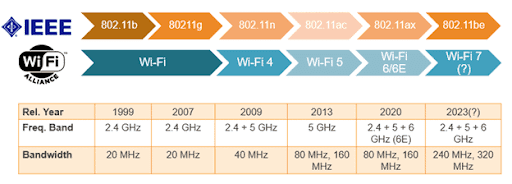Wi-Fi 6E (6Ghz) Design Considerations
Wi-Fi 6E capable networks are few and far between from what I've seen in the wireless world. We have seen a huge uplift of devices capable of accessing this previously unused spectrum. However I've found that wireless networks are still playing catch up when it comes to deploying a 6Ghz capable network.
So to educate a few people and to refresh my own knowledge, this blog post will cover off a bit of background information when it comes to the new 6Ghz spectrum. I'll go over the EU, UK and US standpoints and their differences, client connectivity and overall the challenges that you may come across when designing a 6Ghz capable network (most likely) alongside your existing 2.4Ghz and 5Ghz networks.
The certification was ratified by the Wi-Fi Alliance in 2021, not long after the Wi-Fi 6 standard itself was approved by the IEEE back in 2020. 6E (as I will call it going forward), as previously mentioned allows the use of the 6Ghz spectrum previously unused within the Wi-Fi space. With this has come a huge increase to the usable Wi-Fi frequencies available for your network, whether at home or work environment.
 |
| https://www.litepoint.com/blog/wi-fi-6e-standard-and-channels/ |
The frequency itself has a few differences when it comes to which regulatory body your country sits within. The US/FCC announced in April 2020 the opening of the 6Ghz band, more specifically the ranges of 5925Mhz to 7125Mhz. A few other countries have followed the FCCs lead, such as Canada, the majority of South America and South Korea being an example. This proved a huge increase, totalling 59 20Mhz channels and if your inclined, a potential capability of channel bonding which we'll discuss the viability of later.
Other notable considerations are Europe for example with the range being smaller solely ranging from 5945 - 6425Mhz and finally the UK (my main focus) wanting to one up, 5925 - 6425Mhz an extra 20Mhz head start start. This provides the EU and UK 24 and 25 20Mhz channels respectively.
Side note, the EU/ECC does actually allow 5925, however that portion of the band is reserved solely for rail networks, just in case you see this mentioned in documentation.
If your asking why the other section of the band isn't available 6425 onward (or U-NII6 - 8 for the Americans) in the EU and UK, it come's to other solutions already operating at said higher frequencies. I know from the UK perspective they are most notably satellite services and radio astronomy which may be negatively impacted if allowed (as noted by Ofcom themselves) in the Wi-Fi space.
 |
| https://www.litepoint.com/blog/wi-fi-6e-standard-and-channels/ |
Along side the additional features brought by the Wi-Fi 6 standard (covered in my Wi-Fi 6 Re-Introduction blog post, link below), there is also a few additional changes mandated by the Wi-Fi Alliance for a device to be 6Ghz capable most notably relating to security. You'll have to be aware of these changes when designing and configuring your new 6Ghz SSIDs.
Security has also taken a forced step forward with the use of WPA3. WPA3 announced in 2018, improving upon WPA2, is now a mandated feature of a 6Ghz certified device. This is non-negotiable and if your thinking WPA3 Transition mode think again. There is no backwards compatibility with WPA2 and as a result it will not be allowed.
As mentioned with no backwards compatibility, there will also be a forced use of Simultaneous Authentication of Equals (SAE) replacing PSK, Opportunistic Wireless Encryption (OWE) replacing "open" SSIDs with a form of encryption (still not authentication by itself) and finally Protected Management Frames (PMF), which is a slight pain if you want to capture management packets.
Security as you can see is taken a leap forward by forcing devices to keep up with the not so recent developments with WPA3. Overall this will provide a more secure solution when it comes to 6Ghz networks however you will have to maintain existing SSIDs operating on WPA2 to accommodate legacy devices.
Wi-Fi 6 - A Re-introduction
https://wi-fight-it.blogspot.com/2021/12/wi-fi-6-re-introduction.html
FCC Opens 6 GHz Band to Wi-Fi and Other Unlicensed Uses
https://www.fcc.gov/document/fcc-opens-6-ghz-band-wi-fi-and-other-unlicensed-uses
6GHz harmonisation decision: more spectrum available for better and faster Wi-Fi
https://digital-strategy.ec.europa.eu/en/library/6ghz-harmonisation-decision-more-spectrum-available-better-and-faster-wi-fi
Improving spectrum access for Wi-Fi
https://www.ofcom.org.uk/__data/assets/pdf_file/0036/198927/6ghz-statement.pdf
Spectrum assists drive towards better road and rail safety
https://apps.cept.org/eccnews/dec-2020/spectrum_assists_drive_towards_better_road_and_rail_safety.html
What is Wi-Fi 6E?
https://www.arubanetworks.com/en-gb/faq/what-is-wi-fi-6e/
With Wi-Fi 6E, Is It Time to Consider a Layered Network Approach?
https://www.arubanetworks.com/assets/wp/WP_Wi-Fi-6E.pdf
Cisco Catalyst 9162I, 9164I and 9166I Deployment Guide
https://www.cisco.com/c/en/us/products/collateral/wireless/catalyst-9164-series-access-points/catalyst-9166i-9164i-dg.html#Introduction


Comments
Post a Comment